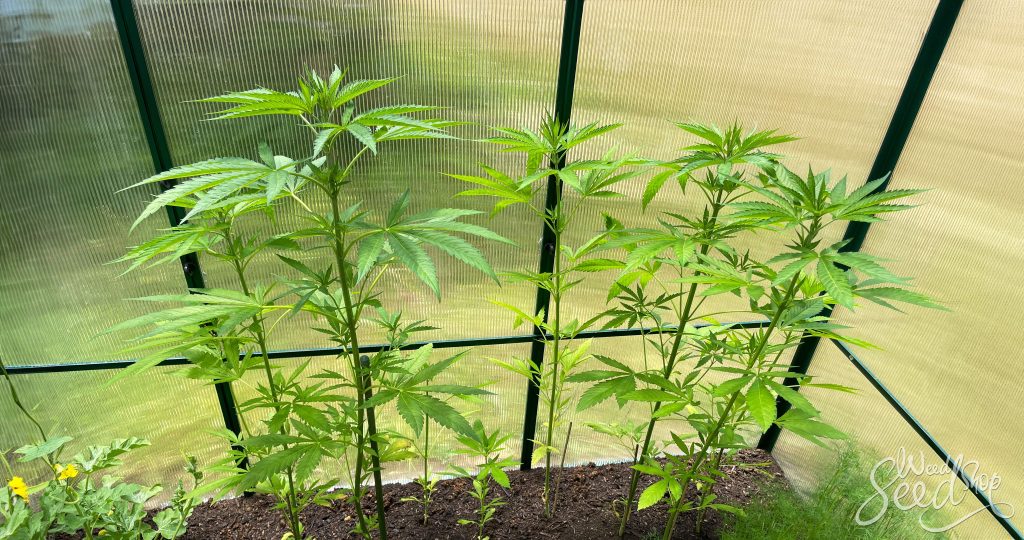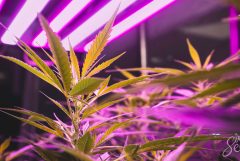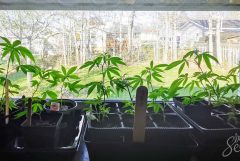Greenhouse growing combines the environmental control of indoors with the space and sunlight of outdoors. If you’ve got the time and space, building your own is an amazing way to extend your growing season, up your yields, and get the most control over your plants.
- What are the advantages of growing weed in a greenhouse?
- What kind of greenhouse do I need?
- How do I build a cannabis greenhouse?
- What’s the best kind of weed for a greenhouse?
- Should I use soil or hydro in a greenhouse?
- Growing weed in a greenhouse FAQs
- What’s next?
Greenhouses offer a controlled environment that lets growers get the most control over environmental factors like temperature and humidity, protection from pests, and increased yield potential. Today, we’re digging into the advantages (and disadvantages) of growing weed in a greenhouse while guiding you through setting up your own greenhouse, selecting the right strains, cultivation techniques, nutrient management, harvesting, and common troubleshooting.
What are the advantages of growing weed in a greenhouse?
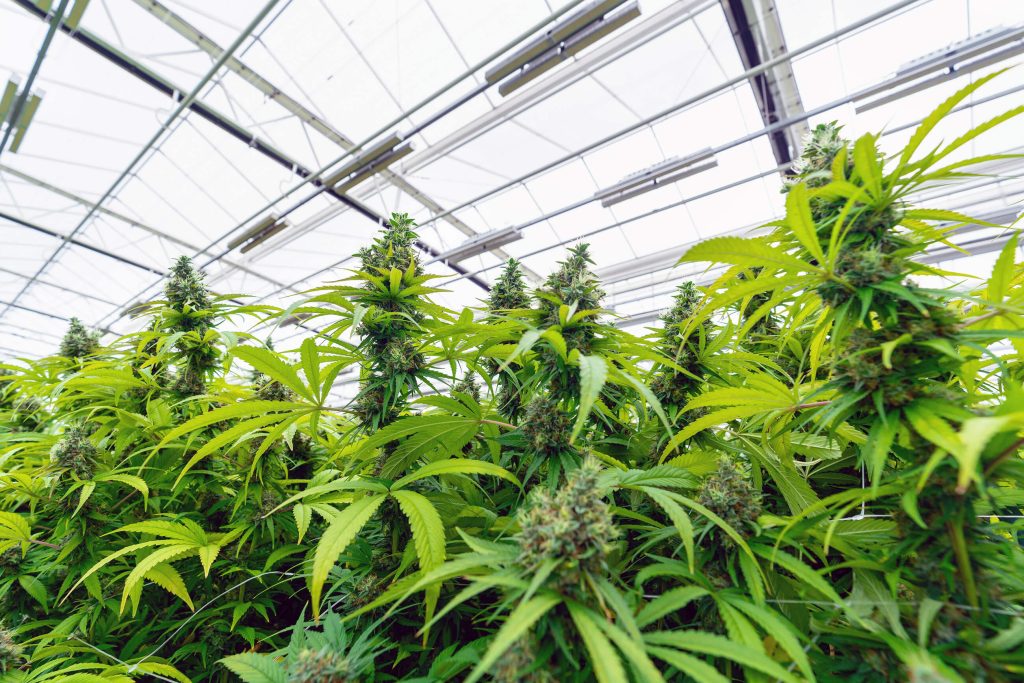
1. Environmental control
Weed grows in virtually any environment, but if you want to get the most out of your plants, you’ll want a warm, humid—almost tropical—setting. Greenhouses offer the perfect solution for growers by providing precise control over temperature and humidity to ensure that plants are kept in as ideal a place as possible, promoting healthy growth and preventing issues from stress.
Further, greenhouses offer the very best protection from harsh weather conditions such as strong winds, heavy rains, or extreme temperatures. This allows growers to extend their growing seasons and produce multiple harvests in a single year.
2. Increased yield
The biggest benefit of growing outdoors is unlimited access to free light. No matter how good of an indoor lamp you’ve got, nothing will ever be able to compete with the sun. Plants grown outdoors will almost always be taller, healthier, and produce significantly more buds than even the best indoor plants.
Unfortunately, for much of the world, the growing season is fairly limited meaning that most growers only have a narrow window to plant. Greenhouses are easily heard and provide protection from the early spring weather. A late frost can and will kill young plants.
By growing in a greenhouse, those using photoperiod seeds can plant them weeks or even months earlier to give them even more time to grow before they start flowering. If you’re growing autoflowering seeds, you can potentially grow all year long in a greenhouse.
3. Cost-effectiveness
Speaking of light, it’s not cheap. Even a small grow can easily use up to 1,000 watts of power on lights alone and those bills add up. By investing in a greenhouse, you can reduce your lighting bill to effectively zero.
4. Pest control
Growing outdoors is a constant battle against various pests. Turns out, bugs love buds. By creating a physical barrier between your plants and the wider world, you can much more easily control what gets in. While many smaller pests like aphids and spider mites can still slip in, these are easily spotted early and can be dealt with. Larger creatures (raccoons, deer, neighbourhood cats), though, will be kept safely at bay.
5. Privacy
Not everyone wants to advertise to the whole world that they’ve got a pot farm in their backyard. A greenhouse is the ultimate “no-questions-asked” solution to keep nosy neighbours out of your business.
What kind of greenhouse do I need?
If you’re planning on building your own greenhouse, be aware that it will take time and money. Getting started is no small feat but if you’ve got the ability to commit to the project, the rewards are more than worth it.
It’s important to remember that getting yourself properly set up before you start growing will save you countless hours of hassle down the road. Don’t rush it and take the time to get everything in place before you plant your first seeds.
There are several basic styles of greenhouse and which one is best for you comes down to space and budget. You should also consider if you want to buy a pre-fabricated unit or build your own.
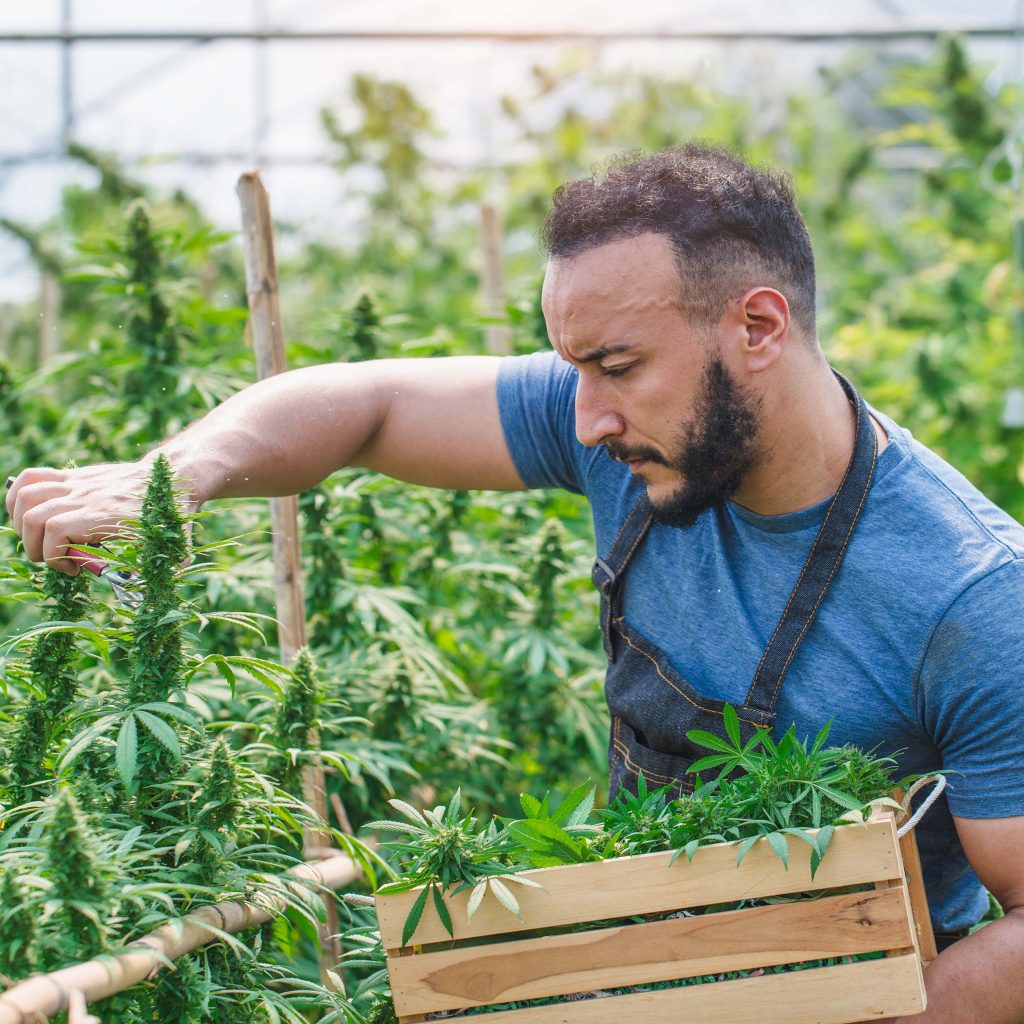
Buying a pre-fab greenhouse
If you’re not the most DIY-inclined person, or you just don’t have the time to commit to a weeks-long project, buying a pre-fabricated greenhouse is always an option. If this is the route you’re looking for, you’ve got three real options to consider: attached, freestanding, and polytunnels.
- Freestanding greenhouses: Probably what most people think of when they picture a “greenhouse” these are stand-alone buildings made of a wood or metal frame with glass, plastic, or fiberglass panels. These are easily the biggest and best option if you’ve got the space and resources.
- Attached greenhouses: These are generally built against a single wall of an already-existing building. This construction means that these are usually far cheaper than a freestanding greenhouse but come with greater restrictions on size and location.
- Polytunnel: The cheapest option and easiest to actually set up, polytunnels are long dome-shaped pseudo-greenhouses. They are usually large enough to walk in but are far less sturdy and secure. Additionally, the plastic covering needs to be replaced every few years.
Building your own greenhouse
If you’ve got the know-how, the tools, and the manpower, building your own greenhouse is definitely an option to consider. This is generally the most cost-effective but labour-intensive option so it’s important to consider which you have more of—time or money.
When planning your greenhouse, be sure to select a location that gets ample sunlight for as much of the day as possible. Remember, the main point of doing this outdoors is to get as much access to the sun as you can. More light = more weed.
Space is another major consideration. You need room for more than just your plants; nutrients, fans, supplemental lighting, and water storage all take up space. Your greenhouse should be your one-stop-shop for all of your grow equipment so give yourself plenty of storage. Also be sure to build it taller than you think you’ll need. Plants grown outdoors can easily grow to heights of 3 metres and you don’t want them to reach the very top of your greenhouse.
Lastly, no matter what size of greenhouse you choose to build, be sure to check your local building codes to make sure that you don’t run into any red tape down the road.
How do I build a cannabis greenhouse?
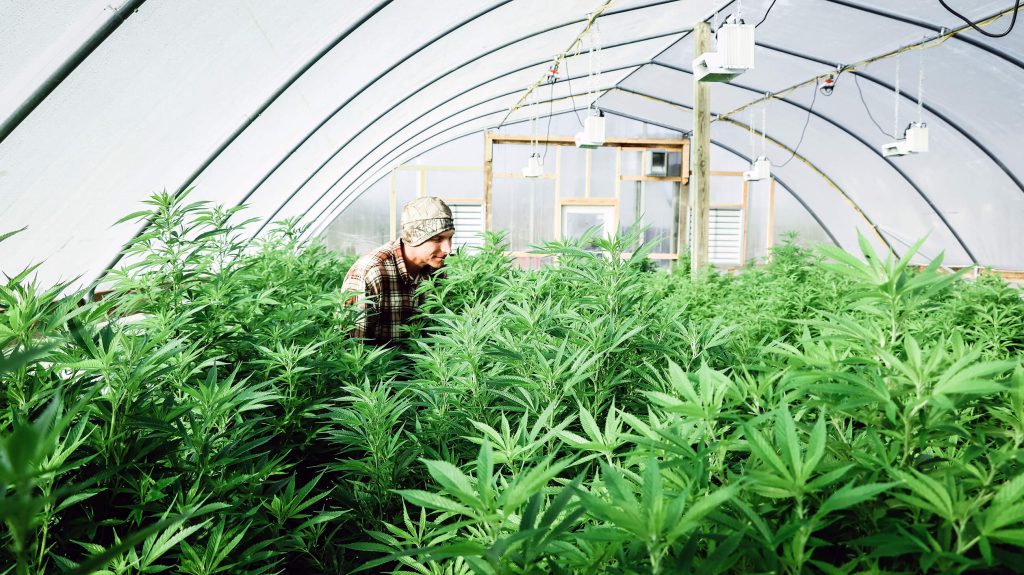
Climate control systems
Keeping your greenhouse in the optimal range of temperature and humidity can be a real challenge in a greenhouse. Unlike indoors, conditions outside can change rapidly and unpredictably. While a greenhouse certainly provides a great deal of protection from the worst of this, you’ll still need to ensure adequate airflow to prevent your plants from getting too hot or too damp.
The ideal temperature range for cannabis is roughly 20-30°C during the day and about 15-20°C at night. As for humidity, 60-70% during vegetation but should be kept to 40-50% during flowering to prevent mould. While plants can survive outside of this range, the flowers will be noticeably smaller and less potent.
If you’re growing in a particularly hot environment, then keeping your greenhouse cool is important and can be a challenge. Extraction fans are always a must as no amount of internal fans will actually keep a room cooler or dryer. When selecting extraction fans, be sure to get one that is powerful enough for your greenhouse.
Air conditioners, electric heaters, humidifiers, and dehumidifiers are all worth considering based on your location. Keeping your greenhouse in the sweet spot is possibly the most important factor for a successful grow.
Lighting options
It’s easy to think that an outdoor greenhouse doesn’t need extra lighting. While that is largely true, many growers do find that they need supplemental lighting to keep things going during the darker months. Likewise, if you don’t have access to a location with a minimum of 10-12 of sunlight a day, you may want to consider additional lights.
Generally speaking, there are two lighting options to consider: natural sunlight and supplemental lighting.
Natural sunlight: Greenhouses are designed to make the most of natural sunlight, which gives plants the full spectrum of light they need. This option is cheap and highly effective. However, it’s not always the most reliable. It’s important to consider factors such as location, seasonality, and potential light obstructions that could affect light availability. Even a particularly dark and stormy week can rob your plants of valuable sunlight.
Supplemental lighting: If, for whatever reason, you just can get enough of the good stuff, supplemental lighting just might be necessary. If you’re growing in the summer, consider LED lights as they emit the least heat. Conversely, growers can kill two birds with one stone by using high-pressure sodium (HPS) lights to both light and heat their greenhouses in the winter. When choosing supplemental lighting, factors such as light intensity, coverage area, energy efficiency, and heat output are important things to keep in mind.
Irrigation and water management
Aside from light, plants need water. Shocking, I know. There are several solutions for watering plants in a greenhouse depending on how much automation you’re looking for.
Manual watering
The easiest, most tried-and-true method out there. Just fill up your watering can, add in the nutrients, and get to it. How often you’ll need to water will depend on the climate, soil, and stage of growth but near the end, you’ll likely be out there every day. This method works well, but it is time-consuming and if you have 20-30 plants, it’s a lot of carrying water around.
If you have access to a hose, you can speed the process up considerably, but it’s important to keep your flowering plants dry. Getting them too wet is a great way to grow unwanted mould.
Automatic irrigation
Setting up an automated irrigation system in your greenhouse is a great way to ensure proper watering while saving time and energy. Perhaps the most common form of automation is drip irrigation which involves delivering water directly to the plant’s root zone through a network of tubes. This allows for precise control over the amount of water delivered to each plant, reducing the risk of over- or under-watering.
This is a fairly low-cost and low-effort project to set up and one that you’ll certainly thank yourself for down the road.
Electricity
Lights, fans, pumps, and sensors all need power. No matter what kind of greenhouse you’re using, you’ll need to find a way to get some juice flowing. Obviously, solar panels make for the best choice as you should be in a place that’s getting plenty of sun. If that’s not an option, a few industrial extension cords should suffice.
Your greenhouse is going to be hot, humid, and dirty. Make sure that any electrical devices are rated for outdoor use.
What’s the best kind of weed for a greenhouse?
With so many types of weed to choose from, it’s important to select a strain that fits your grow space.
Indica vs. sativa in greenhouses
This is always a great place to start when picking what kind of plants you want to grow. Overall, the vast majority of strains today are some form of hybrid with pure indicas and sativas being somewhat rarer. While every plant is different, knowing how much space you need to prepare for is key.
In general terms, sativas grow much taller and slimmer than indicas. If you’ve got a 3-4 metre greenhouse, you can grow some absolute trees in there that will tower over anyone. They’re also usually harder to grow as they’re not as robust as indicas, and greenhouses can create ideal circumstances to grow them. Sativas that love a Mediterranean climate such as Mexican Haze and Gelato White will thrive in a greenhouse. However, sativas tend to produce slightly less and their height can make maintenance a chore.
If you’ve got limited vertical space—or you just don’t want to bust out the ladder every time—indicas tend to stay much shorter and grow outwards into dense bushes. If your goal is to do more with fewer plants, indicas such as Blue Cheese or Critical Kush make a great choice.
Many greenhouse growers do prefer sativa-dominant hybrids as they are simply difficult to grow indoors and getting the most out of your vertical space is a great idea.
Photoperiod vs. autoflowering in a greenhouse
This is another major point to consider and the choice you make will determine your entire grow schedule for the year.
Photoperiod seeds
These seeds flower at a certain time of year—once they start getting less than 12 hours of sunlight in a day. This means that no matter how well-built your greenhouse is, you can only get one full harvest a year without the use of supplemental lighting.
However, greenhouse growers can plant photoperiod seeds earlier than outdoor growers giving them larger plants and an increased yield at the end of the year.
Autoflowering seeds
These plants will flower on their own after a predetermined period of time without any input from a light schedule. This means that they can be grown in a greenhouse all year long—as long as they get enough light. Just because they don’t require a change in light cycles doesn’t mean that they don’t need as much light as you can give them.
With an adequately long growing season, it’s possible to squeeze two full harvests out of some autoflowering plants in a single summer. With supplemental lighting, you can be harvesting all year long.
As a final note, autoflowering versions of strains typically produce less than their photoperiod counterparts. Just because you’re harvesting more often, doesn’t necessarily mean that you’re harvesting more bud. Set on using an autoflower? Opt for one of our high-yielders such as Cookie Kush XXL, Do-Si-Dos, or Critical Mass.
Should I use soil or hydro in a greenhouse?
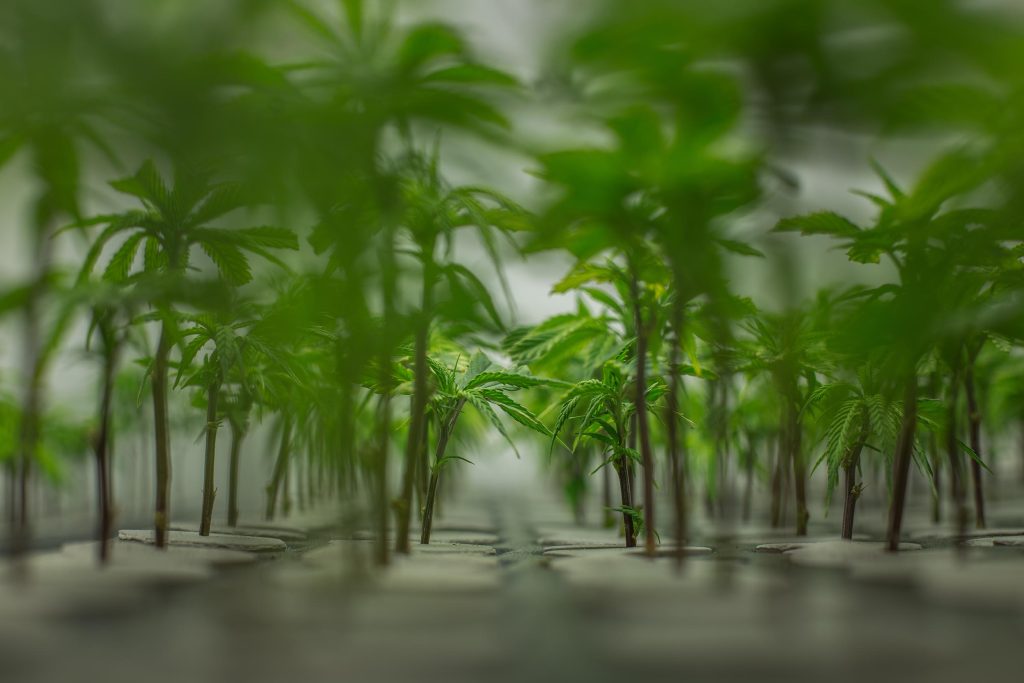
While it is certainly possible to use hydroponics in a greenhouse, the vast majority of growers typically opt for soil. It’s true that hydroponics is generally more efficient, faster, and reduces the risks of certain soil-borne pests, however, the cons of an outdoor hydro system are significant.
First, the price. If you’re already building or buying a greenhouse, another large expense just might not be in the cards at the time. Compared to the costs of building a new hydro setup, especially one big enough to cover an entire greenhouse—the price of a soil setup is, well, dirt cheap.
Secondly, the expertise. Hydroponics setups are complicated enough with 1 or 2 plants and the complexity grows exponentially with every new plant you add. Even if you’ve managed to successfully pull off a number of indoor hydro harvests, you can quickly find yourself overwhelmed by the sheer volume of things that require your attention on a daily basis.
Lastly, the risks. Hydroponics setups are literal breeding grounds for all manner of pathogens that can be dangerous to plants, humans, or both. All it takes is a single contamination to go unnoticed for an entire hydroponic system to become tainted. Putting all of your eggs in one basket is never a good idea.
For these reasons, choosing soil for the growing medium in your greenhouse is almost always the right call.
Preparing your greenhouse soil
Odds are the dirt in your backyard isn’t what you want for growing weed. Luckily, there’s no shortage of commercially available soils designed specifically for growing weed. Check out our article on choosing the best soil for more information. Overall, though, you want loamy soil as it provides the best mixture of water retention, stability, and aeration.
Once you’ve got your hands on some proper dirt, it’s time to get to work. There are two ways to handle plants in a greenhouse; in pots or in the ground.
Growing in pots is always a great choice as it lets you move plants around as needed, get access to every part of them, and even take them out of the greenhouse if you need to do any maintenance. However, plants grown in pots are limited in how large they can grow with bigger pots leading to bigger plants.
Growing directly in the ground requires a fair bit more work as you need to dig a hole for each plant before you get started. These holes should be no smaller than 30cm deep and across and filled with your preferred potting soil. This style allows your plants to grow to their tallest while providing them with the most stability. However, once they’re planted, they can’t be adjusted at all.
Pest and disease management
Bugs love plants and greenhouses are a true paradise for a wide range of pests. While there’s no way to completely keep them out, a few steps of prevention can go a long way.
- Close your doors and windows
It sounds obvious, but by keeping things closed up as much as possible, you limit how much can get in. This is also why it’s so important to have proper ventilation. You NEED constant airflow.
- Use screens
You’re going to have doors and windows open. It’s inevitable. But by using screen doors and window covers, you can do a lot to keep your greenhouse bug-free.
- Hang flypaper
You’ll be shocked and a little grossed out by how quickly these fill up. But by keeping them freshly changed, you’ll keep those bugs off your plants.
- Get some ladybugs
Ladybugs are one of the very best means of controlling pests like aphids. Ladybugs eat pests and leave the plant alone.
Growing weed in a greenhouse FAQs
The cost of setting up a greenhouse for cannabis cultivation can vary widely based on size, materials, and additional features like climate control systems. On average, a basic setup can range from a few hundred to several thousand dollars.
Yes, it’s possible to grow cannabis in a greenhouse during winter, especially if you use heating systems and supplemental lighting. The key is maintaining an optimal environment for your plants.
Proper ventilation is crucial in a greenhouse to regulate temperature, humidity, and prevent the buildup of mould and pests. Automated ventilation systems or manual opening of vents and windows can be used to achieve this.
Natural sunlight is ideal for greenhouses. However, during shorter days or in less sunny climates, supplemental lighting such as LED or high-pressure sodium (HPS) lights may be necessary.
Yes, you can grow various plants alongside cannabis in your greenhouse. Companion planting can be beneficial for pest control and creating a balanced ecosystem.
What’s next?
Growing weed anywhere is always an ongoing struggle. Little things will go wrong here and there and your final harvest will depend on how well and how quickly you can deal with these issues. Luckily, we’ve got in-depth guides on everything you need to know to get started with your own weed grow.
Do you have a greenhouse? Interested in building your own? Share your tips and questions in the comments.




